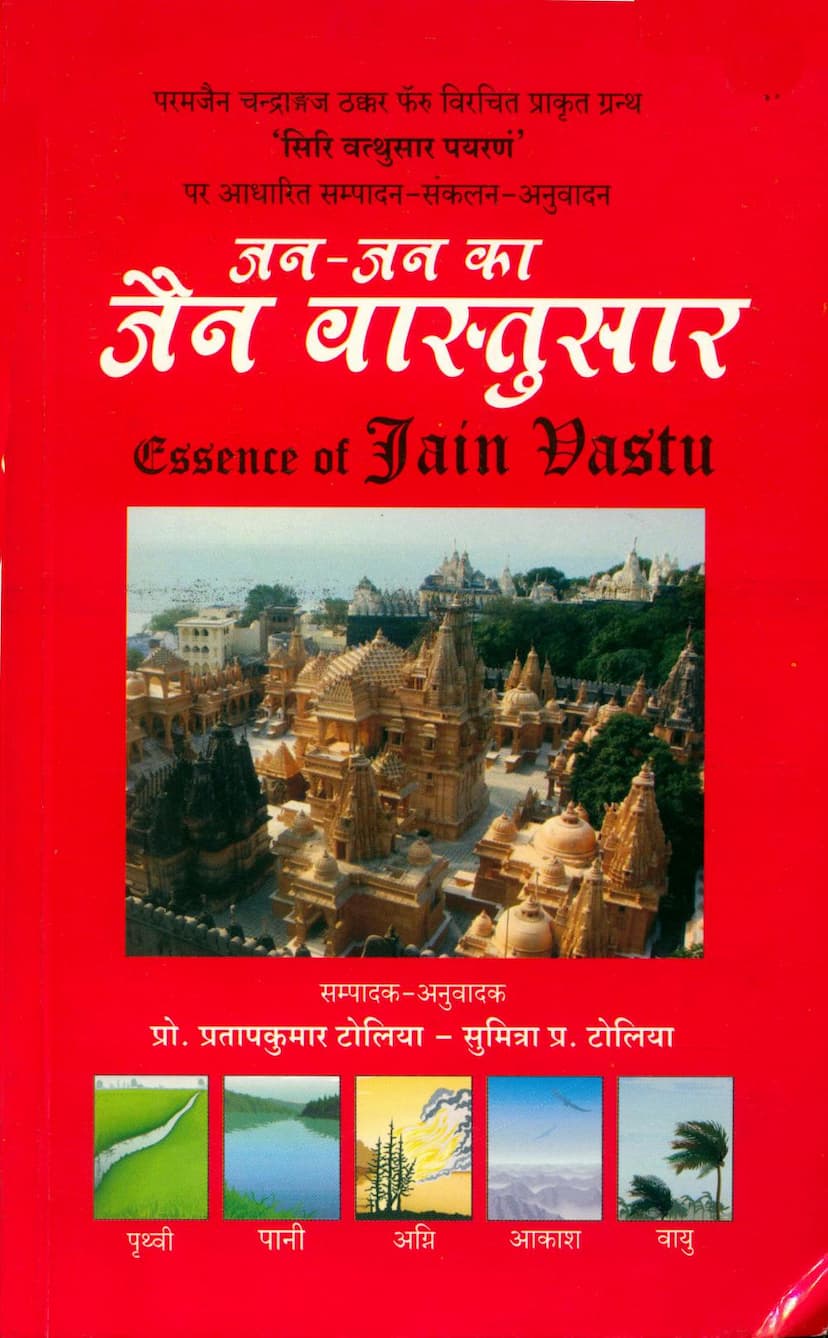Jan Jan Ka Jain Vastusara
Added to library: September 2, 2025

Summary
Here is a comprehensive summary of the Jain text "Jan Jan Ka Jain Vaastu Sara" (Essence of Jain Vastu), based on the provided pages:
Book Title: Jan Jan Ka Jain Vaastu Sara (Essence of Jain Vastu) Author(s): Prof. Pratap Kumar J. Toliya, Sumitra P. Toliya (Editors and Translators) Original Work: 'Siri Vatthusara Payaranam' by Param Jain Chandrangaj Thakur Feru Publisher: Jinabharati Vardhaman Bharati International Foundation Language: Primarily Hindi, with some English sections and Prakrit original references. Core Subject: This book is a comprehensive compilation, editing, and translation of ancient Jain Vastu Shastra principles, particularly based on the Prakrit text 'Siri Vatthusara Payaranam'. It aims to make the knowledge of Jain Vastu accessible to the general public ("Jan Jan").
Key Themes and Content:
-
Foundation of Jain Vastu: The book emphasizes that Vastu Shastra is a science, not superstition, rooted in the five elements of nature (Prithvi, Jal, Agni, Akash, Vayu). It explains how the correct placement and balance of these elements in living spaces are crucial for well-being, harmony, health, and prosperity. The principles are presented as eternal and scientific, applicable universally.
-
Origin and Jain Perspective: It highlights that Jain tradition, originating from the first Tirthankara Lord Adinath, has a rich heritage in Vastu and architecture. While sharing commonalities with Vedic traditions due to the vast Indian cultural heritage, Jain Vastu has distinct specificities. The book acknowledges the loss of much ancient Jain knowledge but emphasizes the valuable Vastu secrets still preserved in Jain texts and structures.
-
Importance of Residential Vastu (Griha Vastu):
- Site Selection (Bhumi Pariksha): This is presented as the most critical first step. It details criteria for selecting land, including water flow direction, soil tests (hole filling), land shape (preferring square/rectangular), purity (free from faults, injuries, living beings), and level (preferring East/North lower than West/South). Various tests for subsurface 'shalya' (bones, impurities) using mantras and geometrical diagrams are provided.
- Directional Placement: The book offers detailed guidance on the appropriate use of different directions and corners of a house.
- North-East (Ishaan Kon): Deemed highly sacred ("Deva Moola"), it's recommended for Deity rooms, water sources, and meditation, emphasizing tranquility. Unholy uses like toilets or kitchens are warned against.
- South-East (Agni Kon): Ideal for kitchens and fire elements.
- South-West (Nairutya Kon): Recommended for bedrooms.
- West: Suitable for dining areas.
- North: For storing wealth and weapons.
- North-West (Vayavya Kon): For machinery and storage.
- East: Primarily for the main entrance (Simha Dwar) and bathrooms.
- Centre (Brahmasthan): Should be kept open and vacant, ideally with a pyramidal structure for energy circulation.
- Specific Elements: Guidance is given on the placement of doors, windows, stairs, toilets, kitchens, water tanks, and other features, with warnings against specific Vastu faults ("Vara-Veedha").
- Dimensions and Measurements: The text elaborates on the "Gaj" (cubit) measurements and proportions for various parts of the house, including the main house structure, verandahs (Alind), pillars, and doors, referencing texts like 'Samarangan Sutradhar' and 'Rajavallabh'. It also discusses the importance of "Ay" (income) calculation for auspiciousness.
- House Types: Various house layouts and their effects are discussed, categorizing them based on the number and placement of rooms (Shala) and verandahs (Alind), such as Shantanu, Shanti-da, etc., and their consequential impacts on residents.
-
Jain Temple Architecture (Jinalaya / Jinaprasad Vastu Shilpa):
- Temple Sites: Jain temples are often located in serene, natural environments, preferably on hilltops or in secluded areas, conducive to meditation and spiritual pursuits.
- Importance of Jin-Pratimaji: The book dedicates significant attention to the Vastu aspects concerning the creation and placement of Jain idols (Jin-Pratimaji). It discusses the selection of materials (stone, wood, metals), qualities of materials (purity, absence of defects), dimensions and proportions of idols (especially the standing and seated Tirthankara postures), and the significance of associated elements like the halo (Bhama-mandal) and other divine figures (Yakshas, Yakshinis, Digpalas).
- Temple Structure: It details the architectural components of Jain temples, including the base (Jagati), plinth levels, the main sanctum (Garbhagriha), walls, pillars (Stambha), various types of spires (Shikhara - often pyramidal), mandapas (pavilions), torans (arches), and water drainage systems (Naali).
- Panchateerthi: The concept of Panchateerthi (a central idol with four surrounding idols) is explained.
- Prohibitions: It lists specific Vastu faults and prohibitions, such as placing doors incorrectly, building on faulty sites, using improper wood for construction, or placing idols in certain undesirable orientations or positions.
- Vastu Purusha Mandala: The text describes the Vastu Purusha Mandala (a grid representing cosmic energies and deities) and the placement of deities within it, emphasizing the need to avoid placing pillars or structures on certain sensitive parts of the cosmic figure.
-
The Role of Prof. Pratap Kumar Tolia: The book highlights the extensive work of Prof. Pratap Kumar Tolia and his wife Sumitra in translating, editing, and publishing this work. It mentions their broader mission through "Vardhaman Bharati" to spread Jain philosophy, meditation, and music, emphasizing principles of Ahimsa, Anekanta, and holistic living. Their personal journey, including dealing with Vastu faults and their connection to spiritual guides, is also referenced.
-
Modern Relevance and Application: The book bridges ancient Jain Vastu principles with modern perspectives, including concepts like PyraVastu and the energy flows within the cosmos ("Cosmic Prana Energy"). It provides practical advice and includes charts and diagrams for easy understanding. It also touches upon the concept of 'Jain Vastu Gram' (Jain Vastu Villages) as an ideal living environment for Jain followers.
Overall Purpose: "Jan Jan Ka Jain Vaastu Sara" serves as an accessible guide to Jain Vastu Shastra for the common person. It aims to educate readers about the scientific basis of Vastu, its Jain specificities, and how to apply these principles for creating harmonious, healthy, and spiritually uplifting living and religious spaces, thereby promoting overall well-being and spiritual progress. It bridges traditional wisdom with contemporary needs, encouraging a mindful and principled approach to construction and living.